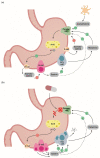Rebound Acid Hypersecretion after Withdrawal of Long-Term Proton Pump Inhibitor (PPI) Treatment-Are PPIs Addictive?
- PMID: 38791497
- PMCID: PMC11122117
- DOI: 10.3390/ijms25105459
Rebound Acid Hypersecretion after Withdrawal of Long-Term Proton Pump Inhibitor (PPI) Treatment-Are PPIs Addictive?
Abstract
Proton pump inhibitors (PPIs) are widely used in the long-term treatment of gastroesophageal reflux disease (GERD) and other upper gastrointestinal disorders, such as the healing of peptic ulcers and/or prophylactic treatment of peptic ulcers. PPIs are also widely used as symptomatic treatment in patients with functional dyspepsia. One of the adverse effects of the long-term use of PPI is rebound acid hypersecretion (RAHS), which can occur after the withdrawal of PPI therapy due to a compensatory increase in gastric acid production. Mechanisms of the RAHS have been well established. Studies have shown that pentagastrin-stimulated acid secretion after the discontinuation of PPIs increased significantly compared to that before treatment. In healthy volunteers treated with PPIs, the latter induced gastrointestinal symptoms in 40-50% of subjects after the discontinuation of PPI therapy but after stopping the placebo. It is important for practicing physicians to be aware and understand the underlying mechanisms and inform patients about potential RAHS before discontinuing PPIs in order to avoid continuing unnecessary PPI therapy. This is important because RAHS may lead patients to reuptake PPIs as symptoms are incorrectly thought to originate from the recurrence of underlying conditions, such as GERD. Mechanisms of RAHS have been well established; however, clinical implications and the risk factors for RAHS are not fully understood. Further research is needed to facilitate appropriate management of RAHS in the future.
Keywords: discontinuation; gastrin; proton pump inhibitors; rebound acid hypersecretion; withdrawal.
Conflict of interest statement
The authors declare no conflict of interest.
Figures


Similar articles
-
Systematic review: symptoms of rebound acid hypersecretion following proton pump inhibitor treatment.Scand J Gastroenterol. 2013 May;48(5):515-22. doi: 10.3109/00365521.2012.746395. Epub 2013 Jan 14. Scand J Gastroenterol. 2013. PMID: 23311977
-
Proton-pump inhibitor therapy induces acid-related symptoms in healthy volunteers after withdrawal of therapy.Gastroenterology. 2009 Jul;137(1):80-7, 87.e1. doi: 10.1053/j.gastro.2009.03.058. Epub 2009 Apr 10. Gastroenterology. 2009. PMID: 19362552 Clinical Trial.
-
Gastroesophageal reflux disease-related symptom recurrence in patients discontinuing proton pump inhibitors for Bravo® wireless esophageal pH monitoring study.Rev Gastroenterol Mex. 2017 Oct-Dec;82(4):277-286. doi: 10.1016/j.rgmx.2016.12.007. Epub 2017 Apr 3. Rev Gastroenterol Mex. 2017. PMID: 28385467 English, Spanish.
-
Problems Associated with Deprescribing of Proton Pump Inhibitors.Int J Mol Sci. 2019 Nov 2;20(21):5469. doi: 10.3390/ijms20215469. Int J Mol Sci. 2019. PMID: 31684070 Free PMC article. Review.
-
AGA Clinical Practice Update on De-Prescribing of Proton Pump Inhibitors: Expert Review.Gastroenterology. 2022 Apr;162(4):1334-1342. doi: 10.1053/j.gastro.2021.12.247. Epub 2022 Feb 17. Gastroenterology. 2022. PMID: 35183361 Review.
Cited by
-
Comparing Proton Pump Inhibitors and Emerging Acid-Suppressive Therapies in Gastroesophageal Reflux Disease: A Systematic Review.Cureus. 2025 May 17;17(5):e84311. doi: 10.7759/cureus.84311. eCollection 2025 May. Cureus. 2025. PMID: 40535413 Free PMC article. Review.
-
Knowledge, Attitudes, and Practices of Community Pharmacists Regarding Proton Pump Inhibitor (PPI) Use: A Cross-Sectional Study.Healthcare (Basel). 2025 Jul 2;13(13):1588. doi: 10.3390/healthcare13131588. Healthcare (Basel). 2025. PMID: 40648613 Free PMC article.
-
Profound gastric mucosal changes and severe rebound acid hypersecretion after long-term Vonoprazan use: A case report.DEN Open. 2024 Dec 21;5(1):e70046. doi: 10.1002/deo2.70046. eCollection 2025 Apr. DEN Open. 2024. PMID: 39712905 Free PMC article.
-
Trends in Proton Pump Inhibitor Use in Sweden by Sex and Age: A Drug Utilisation Study.Drug Saf. 2025 Apr;48(4):389-400. doi: 10.1007/s40264-024-01502-9. Epub 2024 Dec 8. Drug Saf. 2025. PMID: 39645619 Free PMC article.
-
Pharmacotherapeutic actions related to drug interaction alerts - a questionnaire study among Swedish hospital interns and residents in family medicine.Eur J Clin Pharmacol. 2025 Feb;81(2):301-308. doi: 10.1007/s00228-024-03785-4. Epub 2024 Dec 16. Eur J Clin Pharmacol. 2025. PMID: 39680076 Free PMC article.
References
Publication types
MeSH terms
Substances
LinkOut - more resources
Full Text Sources
Medical

